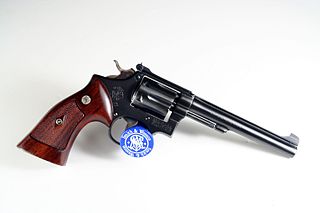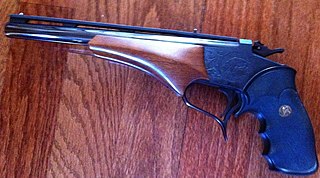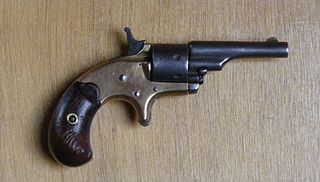
A revolver is a repeating handgun that has at least one barrel and uses a revolving cylinder containing multiple chambers for firing. Before firing a round, cocking the hammer partially rotates the cylinder, indexing one of the cylinder chambers into alignment with the barrel, allowing the bullet to be fired through the bore. The hammer cocking can be achieved by either the user manually pulling the hammer back, via internal linkage relaying a rearward movement of the trigger, or both. By sequentially rotating through each chamber, the revolver allows the user to fire multiple times until having to reload the gun, unlike older single-shot firearms that had to be reloaded after each shot.

A derringer is a small handgun that is neither a revolver nor a semi/fully automatic pistol. It is not to be confused with mini-revolvers or pocket pistols, although some later derringers were manufactured with the pepperbox configuration. The modern derringer is often multi-barreled, and is generally the smallest usable handgun of any given caliber and barrel length due to the lack of a moving action, which takes up more space behind the barrel. It is frequently used by women because it is easily concealable in a purse or a stocking.

The LeMat revolver was a .42 or .36 caliber cap & ball black powder revolver invented by Jean Alexandre LeMat of France, which featured an unusual secondary 20 gauge smooth-bore barrel capable of firing buckshot. It saw service with the armed forces of the Confederate States of America during the American Civil War of 1861–65 and the Army of the Government of National Defense during the Franco-Prussian War.
Christian Sharps was the inventor of the Sharps rifle, the first commercially successful breech-loading rifle and the Sharps Four Barrel Pistol.

The Remington-Rider Single Shot Derringer Parlor Pistol was made by E. Remington and Sons between 1860 and 1863. Only two hundred were produced.

H&R 1871, LLC is a manufacturer of firearms under the Harrington & Richardson and New England Firearms trademarks. H&R is a subsidiary of JJE Capital Holdings. H&R ceased production February 27, 2015.

The Smith & Wesson Model 17 is a six-shot double-action revolver chambered for .22 LR. It is built on Smith & Wesson's medium-sized K-frame.

The Thompson/Center Contender is a break-action single-shot pistol or rifle that was introduced in 1967 by Thompson/Center Arms. It can be chambered in cartridges from .22 Long Rifle to .45-70 Government.

The Semmerling LM4 is a five-shot, manually repeating double-action pocket pistol.

The Remington-Beals Model Revolvers along with subsequent models and variations were percussion revolvers manufactured by Eliphalet Remington & Sons in .31 (Pocket) .36 (Navy) or .44 (Army) caliber, used during the American Civil War, and was the beginning of a successful line of medium and large frame pistols. They are commonly, though inaccurately, referred to as the Model 1858 due to the patent markings on its New Model barrels, "PATENTED SEPT. 14, 1858/E. REMINGTON & SONS, ILION, NEW YORK, U.S.A./NEW MODEL."; although wide scale production did not start until 1861.

A handgun is a short-barrelled firearm that can be held and used with one hand. The two most common handgun sub-types in use today are revolvers and semi-automatic pistols, although other handgun-types such as derringers and machine pistols also see infrequent usage.

The Protector Palm Pistol is a small .32 rimfire revolver designed to be concealed in the palm of the hand. It was unique in that the revolver was clasped in a fist with the barrel protruding between two fingers and the entire handgun was squeezed in order to fire a round.

The Remington Model 95 is a double-barrel pocket pistol commonly recognized as a Derringer. The design was little changed during a production run of nearly 70 years through several financial reorganizations of the manufacturer causing repeating serial number sequences. Guns were offered with engraving or plain blued or nickel-plated finish with grips of metal, walnut, rosewood, hard rubber, ivory or pearl.

Remington Model 1875 Single Action Army was a revolver by E. Remington & Sons. It was based upon the successful New Model Army with both revolvers having the same size, appearance, and the removable cylinder. The new 1875 Remington differed mainly from the older 1858 percussion model by having a bored through cylinder chambered for metallic cartridges. Thus, in 1875, Remington entered the cartridge revolver market with this big-frame, army style revolver, intended to compete with the Colt Peacemaker. Ordinary citizens and Old West lawmen alike recognized the sturdy quality of the new Remington revolvers. This design was followed by the Model 1888 and the Model 1890.

The Colt Model 1855 Sidehammer, also known as the Colt Root Revolver after engineer Elisha K. Root (1808–1865), was a cap & ball single-action pocket revolver used during the American Civil War and made by the Colt's Patent Fire Arms Manufacturing Company

The Colt House Revolver was one of the first metallic cartridge rear-loading revolvers to be produced by the Colt's Patent Fire Arms Manufacturing Company, back in 1871. The same year, Colt's also patented the Colt Open Top, another metallic cartridge rear-loader, but in fact the Open Top production didn't start until 1872, although a pocket version of the Open Top, a completely different design, went on sales as of 1871, the Colt Open Top Pocket Model Revolver.

The Colt Model 1871–72 Open Top is a metallic cartridge rear-loading .44-caliber revolver introduced in 1872 by the Colt's Patent Fire Arms Manufacturing Company. This handgun was developed following two patents, the first one in 1871 and the second one in 1872, it is estimated that the production span lies primarily between February 1872 and June 1873. There is therefore still some confusion when naming it. It is sometimes named Colt Model 1871 or Colt Model 1872 but at this time the most common accepted names are Colt Model 1871–72 Open Top, Colt Model 1871–72 or simply Colt Open Top.

The Remington Model 1890 New Model Army was a revolver by Remington Arms. It was based on the successful Remington Model 1875 and the lesser known Model 1888 with both revolvers having the same size, appearance, and the removable cylinder. The 1890 Remington single-actions kept the solid frame and similar styling of the 1875 model, but lacking the large web under the ejector rod housing and equipped with checkered rubber grips. Like the 1875 model, the 1890 was suitably made for metallic cartridges, but only issued in .44-40 caliber.

The Colt Open Top Pocket Model Revolver was a single action pocket revolver introduced by the Colt's Patent Fire Arms Manufacturing Company in 1871. Introduced a year before the Colt Open Top and two years before the Colt Peacemaker and the Colt New Line, the Colt Open Top Pocket Model Revolver was, alongside the Colt House Revolver, one of the two first metallic cartridge rear-loading revolvers manufactured by Colt's. It also was one of the first pocket metallic cartridge revolvers made by the company.
Forehand & Wadsworth was an American firearms manufacturing company based in Worcester, Massachusetts. It was formed in 1871 by Sullivan Forehand and Henry C. Wadsworth after the death of their father-in-law, Ethan Allen of Ethan Allen & Company, and was acquired in 1902 by Hopkins & Allen, a firearms company based in Connecticut.



















